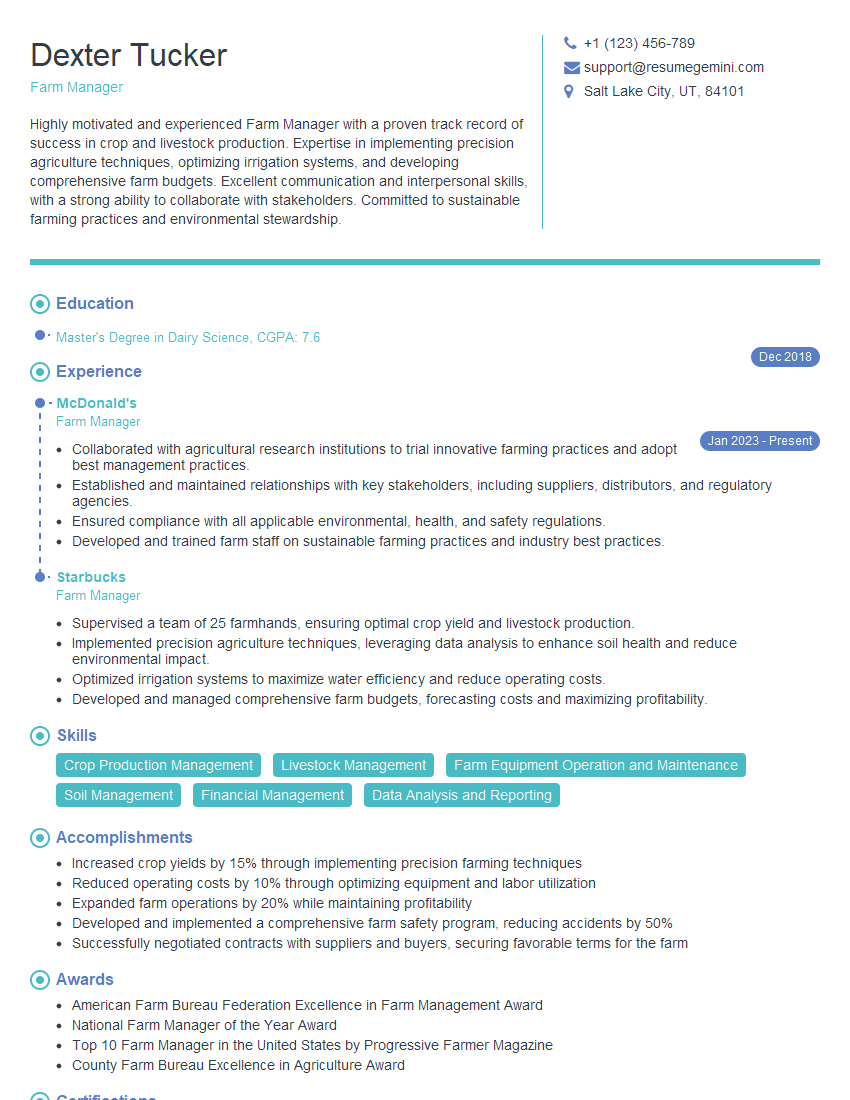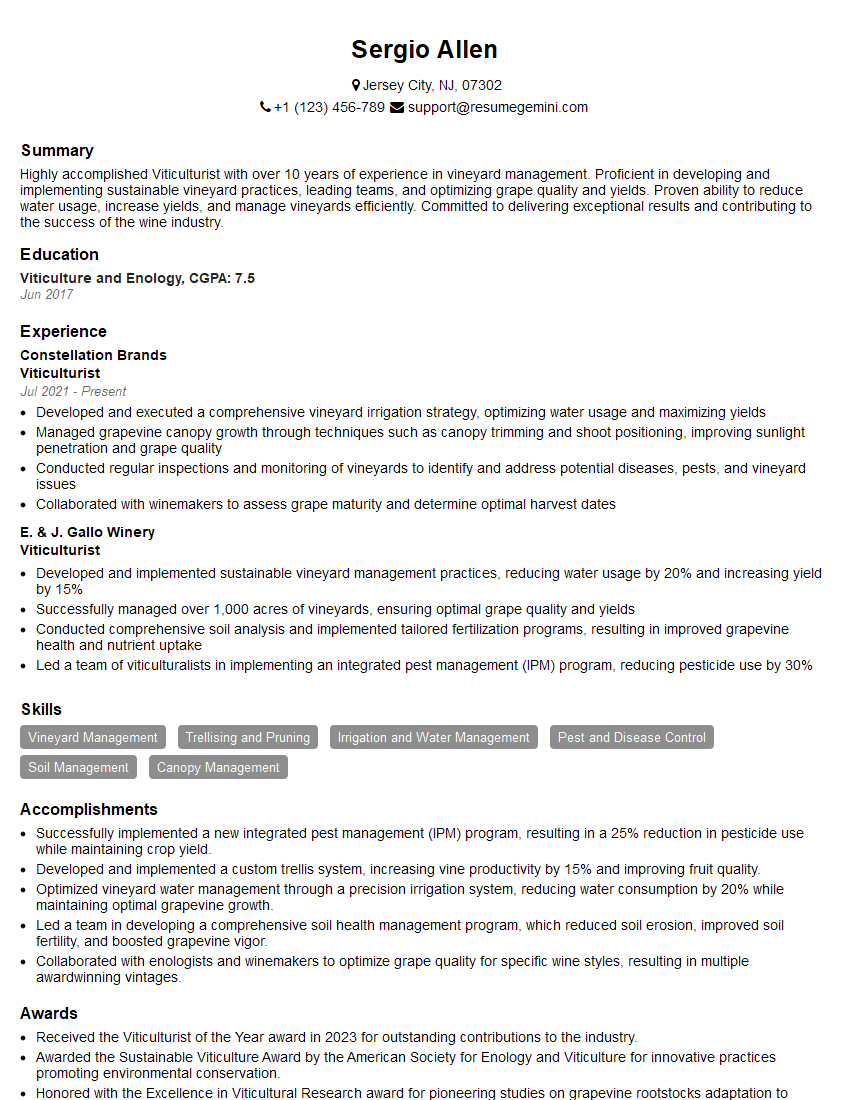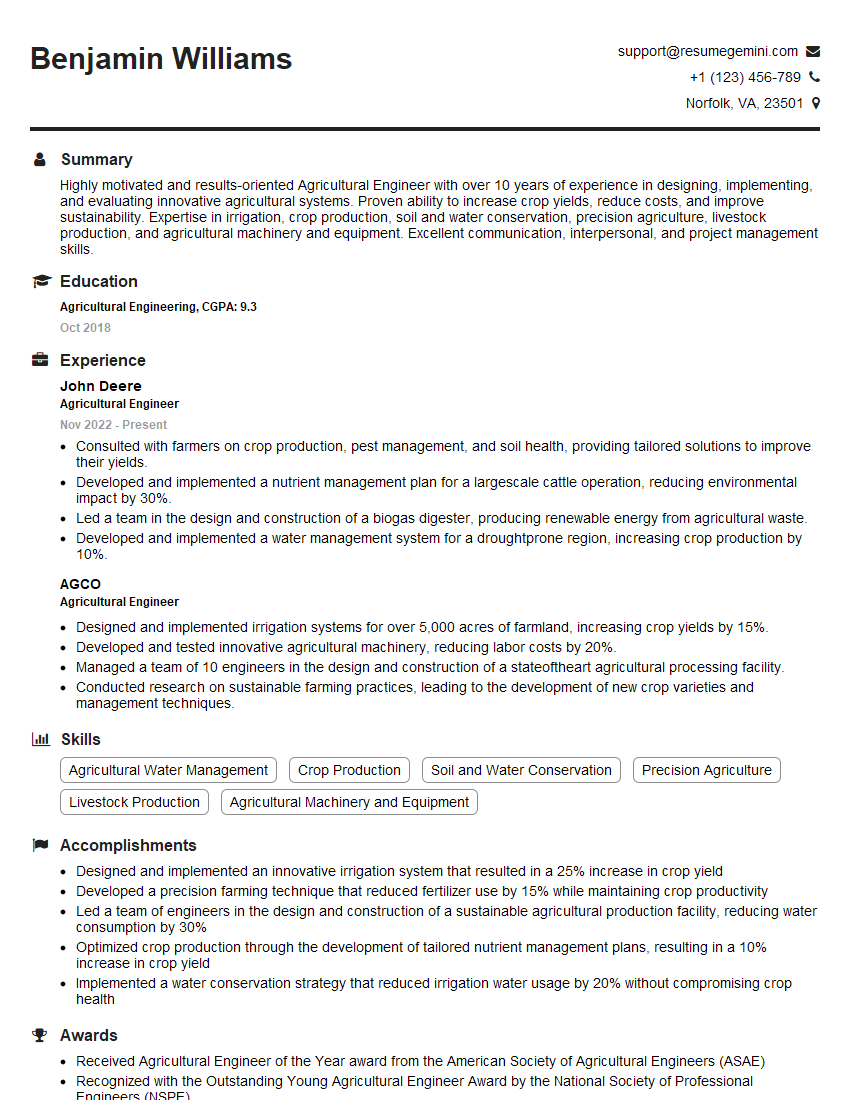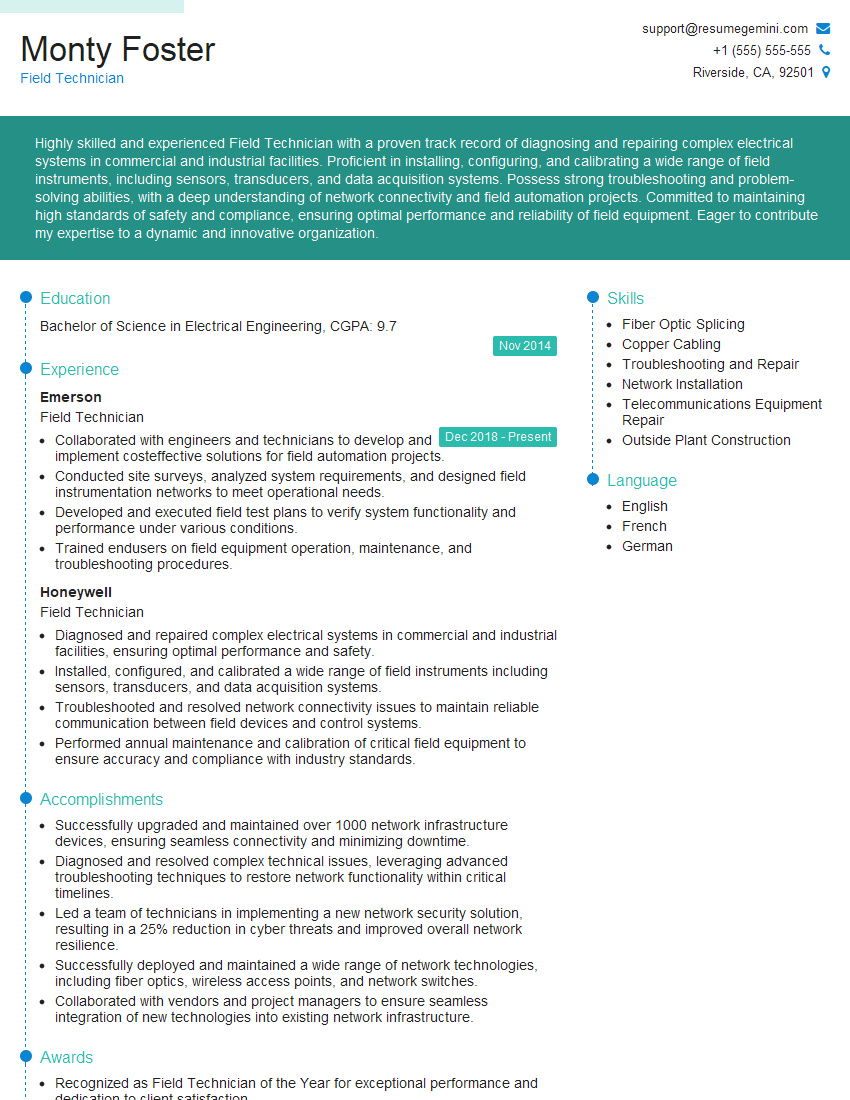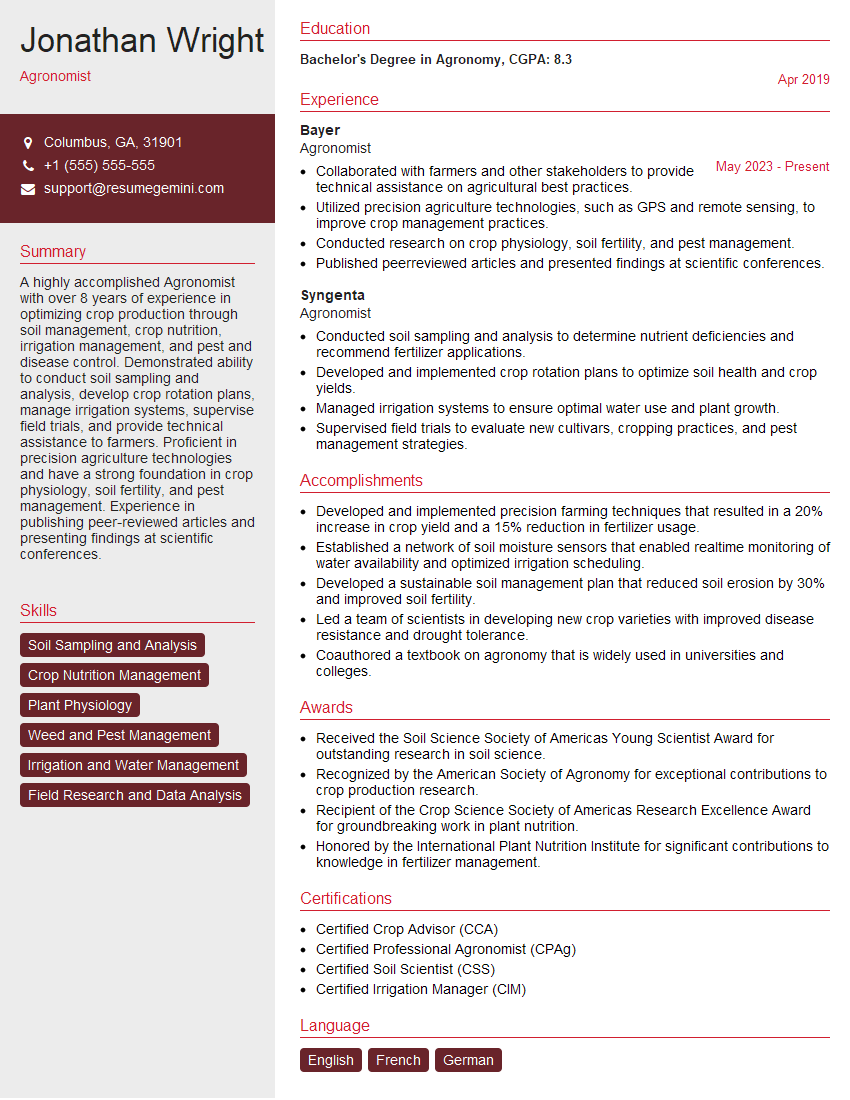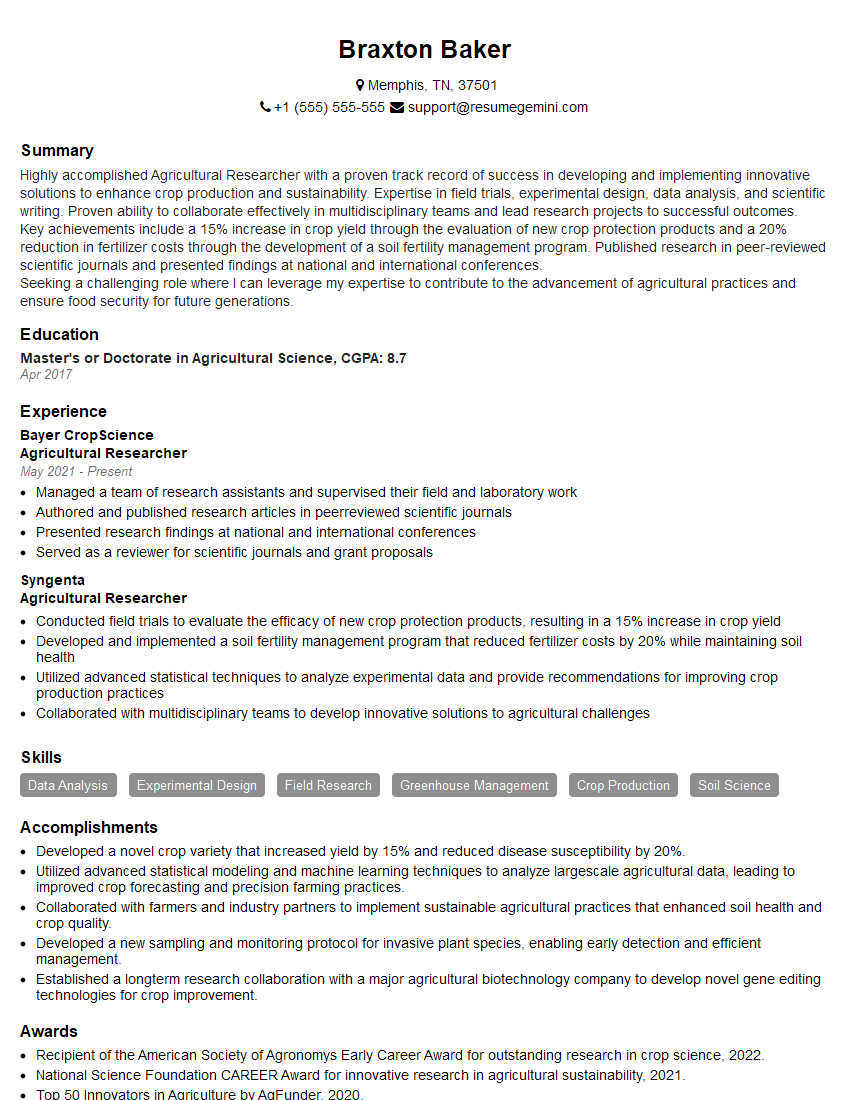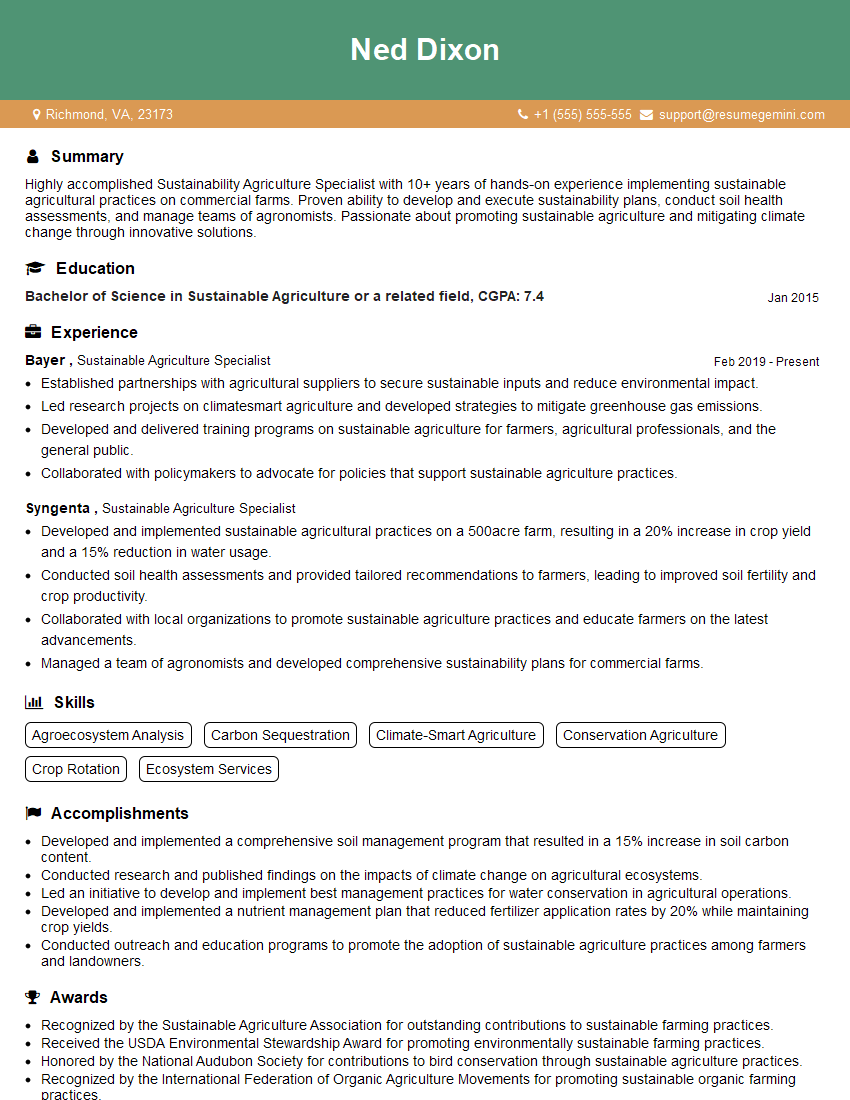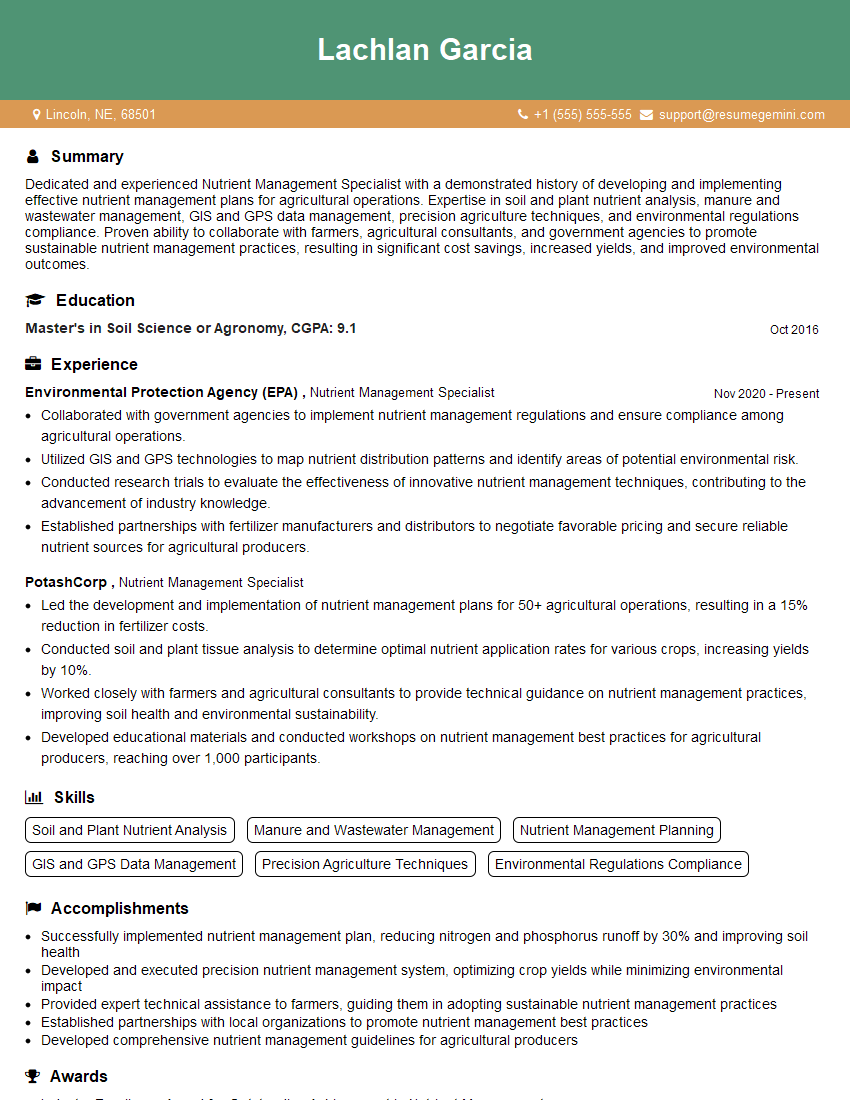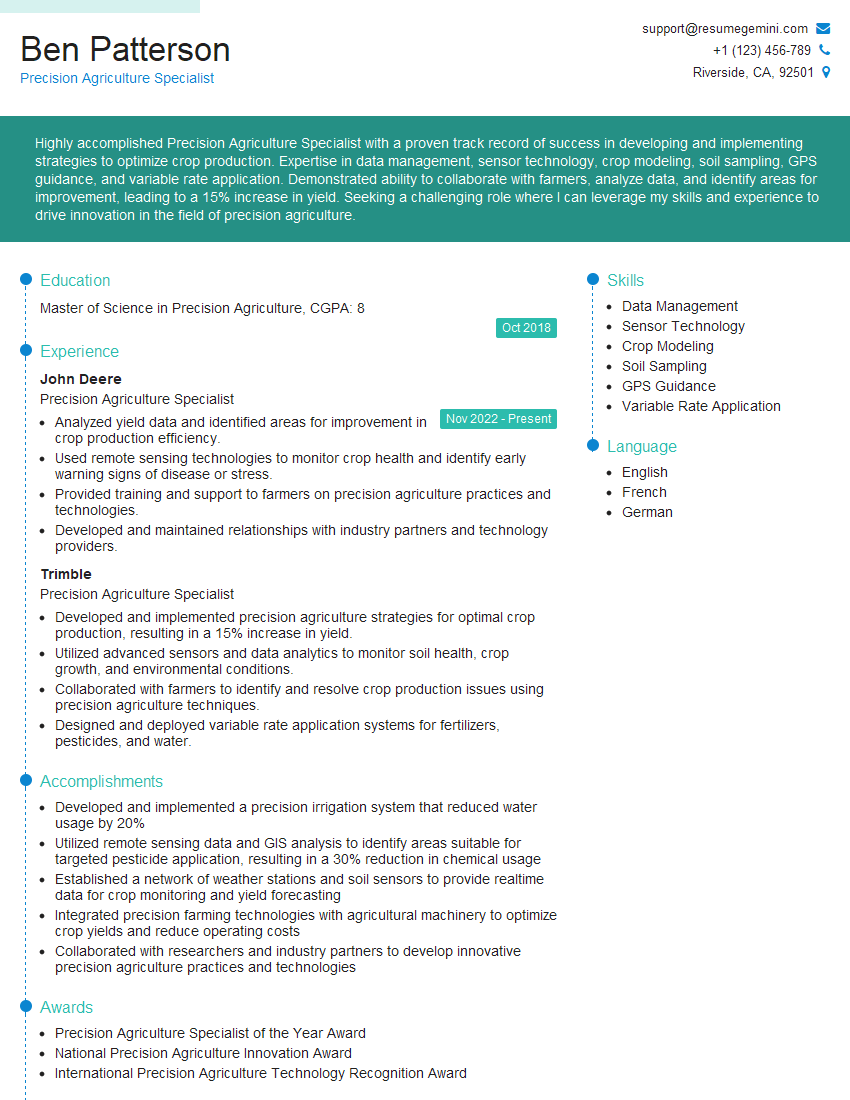The thought of an interview can be nerve-wracking, but the right preparation can make all the difference. Explore this comprehensive guide to Fertilizing Crops interview questions and gain the confidence you need to showcase your abilities and secure the role.
Questions Asked in Fertilizing Crops Interview
Q 1. What are the three primary macronutrients plants require?
Plants need a variety of nutrients to thrive, but three stand out as primary macronutrients because they are required in significantly larger quantities than other nutrients. These are Nitrogen (N), Phosphorus (P), and Potassium (K). Think of them as the fundamental building blocks for healthy plant growth.
- Nitrogen (N): Essential for leaf growth, vibrant green color, and overall plant vigor. A nitrogen deficiency shows up as yellowing leaves.
- Phosphorus (P): Crucial for root development, flowering, fruiting, and overall plant maturity. Phosphorus deficiency often manifests as stunted growth and purplish discoloration of leaves.
- Potassium (K): Important for disease resistance, water regulation, and overall plant strength. Potassium deficiency can lead to weak stems, scorched leaf margins, and reduced yields.
Understanding the role of these macronutrients is crucial for effective fertilization, as imbalances can significantly impact crop yield and quality.
Q 2. Explain the difference between organic and inorganic fertilizers.
The main difference between organic and inorganic fertilizers lies in their source and how they release nutrients.
- Inorganic fertilizers, also known as synthetic or mineral fertilizers, are manufactured using chemical processes. They provide readily available nutrients in a concentrated form. Think of them as fast-acting, providing a quick boost of nutrients. Examples include ammonium nitrate (for nitrogen) and triple superphosphate (for phosphorus).
- Organic fertilizers are derived from natural sources like animal manure, compost, and plant residues. They release nutrients slowly through natural decomposition processes. This slow release is beneficial for long-term soil health, acting like a time-release capsule of nutrients. Examples include cow manure, chicken litter, and peat moss.
The choice between organic and inorganic fertilizers depends on factors such as crop needs, soil conditions, environmental concerns, and budget. Often, a blend of both provides optimal results.
Q 3. Describe the process of soil testing and how the results inform fertilizer application.
Soil testing is a critical first step in determining fertilizer needs. It involves collecting soil samples from representative areas of the field, analyzing them in a laboratory, and interpreting the results to understand the soil’s nutrient content and pH.
The process typically involves:
- Sampling: Collecting soil samples at various points across the field to obtain a representative sample.
- Laboratory analysis: Sending the samples to a lab for analysis of nutrient levels (N, P, K, and micronutrients), pH, organic matter content, and other relevant properties.
- Interpretation: Receiving the results and interpreting them to identify nutrient deficiencies or excesses. This often involves comparing the results to crop-specific nutrient requirements.
The results from soil testing directly inform fertilizer application by indicating the specific nutrients and amounts needed to meet the crop’s requirements and optimize yield. For example, if the test reveals low phosphorus levels, the fertilizer plan will incorporate a phosphorus-rich fertilizer.
Q 4. What are the common methods of fertilizer application?
Several methods exist for applying fertilizers, each with its own advantages and disadvantages:
- Broadcasting: Spreading fertilizer evenly over the entire field surface. This method is relatively simple and inexpensive, but can lead to nutrient loss through runoff or volatilization (loss to the air).
- Banding: Placing fertilizer in narrow bands near the seed or plant rows. This method improves nutrient efficiency by placing the fertilizer directly where roots can readily access it.
- Drilling: Applying fertilizer directly into the soil at a specific depth. This technique minimizes nutrient loss and improves nutrient availability.
- Foliar application: Spraying fertilizer directly onto the leaves of plants. This method is particularly useful for micronutrient application and fast plant response in case of deficiencies.
- Fertigation: Applying fertilizer through an irrigation system. This method ensures uniform nutrient distribution and efficient use of water and fertilizer.
The best method depends on the type of fertilizer, crop, soil conditions, and available equipment.
Q 5. Explain the concept of nutrient uptake by plants.
Nutrient uptake by plants is a complex process involving the absorption of essential nutrients from the soil solution through the root system. Roots release various compounds and create a favorable environment that helps in dissolving and transporting nutrients to the root surface. The plant absorbs nutrients actively (requiring energy) and passively (driven by concentration gradients).
The process can be visualized like this: Nutrients in the soil are dissolved in water and become available for uptake. Root hairs, tiny extensions of the roots, increase the surface area for absorption. The nutrients then travel through the xylem (a vascular tissue) to other parts of the plant where they are used for growth and development.
Factors affecting nutrient uptake include soil pH, temperature, moisture content, oxygen availability, and the presence of other ions in the soil that might compete with the uptake process.
Q 6. How do you determine the appropriate fertilizer rate for a specific crop?
Determining the appropriate fertilizer rate is crucial for maximizing crop yields without causing environmental harm or wasting resources. It’s a balancing act. Several factors guide this decision.
- Soil test results: As mentioned before, soil tests provide critical information on existing nutrient levels. The fertilizer recommendation will fill the gap between existing and required nutrient levels.
- Crop nutrient requirements: Each crop has specific nutrient demands at different growth stages. Crop-specific guidelines and research data provide targets for fertilizer applications.
- Yield goals: Higher yield goals usually necessitate higher fertilizer rates, but only up to a point; excessive fertilizer beyond a threshold will not necessarily provide proportional yield increases.
- Soil type and climate: Soil texture, organic matter content, and climatic conditions influence nutrient availability and uptake. For instance, sandy soils require more frequent fertilization than clay soils due to higher nutrient leaching.
Often, fertilizer recommendations are expressed as pounds per acre or kilograms per hectare of a specific nutrient (e.g., 100 lbs/acre of N). These recommendations can be obtained from local agricultural extension services or fertilizer companies.
Q 7. What factors influence fertilizer choice?
Many factors influence the choice of a particular fertilizer:
- Crop needs: Different crops have different nutrient requirements. A nitrogen-rich fertilizer might be ideal for leafy greens, while a phosphorus-rich one is more suitable for fruiting crops.
- Soil conditions: Soil pH and texture influence nutrient availability and the choice of fertilizer formulation. For example, acidic soils might require lime application in addition to fertilizer.
- Nutrient availability: Slow-release fertilizers are preferred when consistent nutrient supply is needed, while fast-release fertilizers are used for immediate nutrient deficiencies.
- Environmental considerations: The environmental impact of fertilizers is a major concern. Choosing environmentally friendly options, minimizing runoff, and practicing responsible fertilizer management are crucial for sustainability.
- Cost: Fertilizer costs vary considerably. Choosing the most cost-effective fertilizer while meeting the crop’s needs is essential for profitability.
- Application method: The chosen fertilizer must be compatible with the application method (e.g., broadcasting, banding, foliar).
A holistic approach considers all these factors to select the most appropriate fertilizer for a specific situation.
Q 8. Discuss the environmental impacts of fertilizer use.
Fertilizer use, while crucial for boosting crop yields, carries significant environmental consequences. The primary impact stems from nutrient runoff. Excess nitrogen and phosphorus, not absorbed by plants, leach into waterways, causing eutrophication – a process where excessive nutrients fuel algal blooms. These blooms deplete oxygen, creating ‘dead zones’ that harm aquatic life. Furthermore, the production of fertilizers is energy-intensive, contributing to greenhouse gas emissions, primarily nitrous oxide (N2O), a potent greenhouse gas far more effective at trapping heat than carbon dioxide. Ammonia volatilization from nitrogen fertilizers also contributes to air pollution and acid rain. Improper fertilizer handling and storage can lead to soil and water contamination with harmful chemicals. Finally, some fertilizers, particularly those containing phosphates, are mined from finite resources, raising concerns about resource depletion.
Imagine a lake choked with algae, suffocating the fish below – this is a direct consequence of fertilizer runoff. Understanding these impacts is crucial for developing sustainable agricultural practices.
Q 9. What are best management practices to minimize fertilizer runoff?
Minimizing fertilizer runoff requires a multi-pronged approach encompassing best management practices (BMPs). These practices focus on optimizing fertilizer application to match crop needs, minimizing losses to the environment. Key BMPs include: precise application techniques (e.g., variable rate fertilization based on soil tests), using slow-release fertilizers to reduce leaching, integrating cover crops to absorb excess nutrients, applying fertilizer before or during rainfall to minimize surface runoff, establishing buffer strips of vegetation along waterways, and employing conservation tillage to reduce soil erosion. Proper timing of fertilizer application, taking into account rainfall patterns and crop growth stages, is also crucial. Regular soil testing helps tailor fertilizer application to actual nutrient needs, reducing unnecessary fertilizer use and subsequent environmental impact.
For example, a farmer using variable rate fertilization would apply higher rates of fertilizer in areas where the soil is nutrient deficient and lower rates in areas with sufficient nutrients. This targeted approach greatly reduces the risk of runoff compared to uniform application across the entire field.
Q 10. How do you address nutrient deficiencies in crops?
Addressing nutrient deficiencies begins with accurate diagnosis. Soil testing is paramount, providing a snapshot of the existing nutrient levels. Based on the test results, the appropriate fertilizer is selected to correct the deficiency. This is often a blend of macronutrients (nitrogen, phosphorus, and potassium) and micronutrients, tailored to the specific needs of the crop and soil conditions. In addition to soil testing, visual symptoms of deficiency (discussed in the next question) can also guide decision-making. Foliar feeding, where nutrients are applied directly to the leaves, can offer a rapid response to severe deficiencies. However, this method is often more expensive and may not be suitable for long-term nutrient management. A holistic approach, considering soil health, crop rotation, and integrated pest management, is more sustainable than relying solely on chemical fertilizers.
Imagine a doctor diagnosing an illness through blood tests before prescribing medication – it’s the same principle in addressing nutrient deficiencies in crops. Accurate diagnosis is key to effective treatment.
Q 11. What are the symptoms of nitrogen, phosphorus, and potassium deficiencies?
Nutrient deficiency symptoms vary depending on the nutrient and the plant species. However, some common indicators are:
- Nitrogen (N): Stunted growth, pale yellowing of older leaves (chlorosis), reduced tillering (branching) in cereals. Think of a plant lacking the energy to grow, resulting in small size and pale colour.
- Phosphorus (P): Dark green or purplish leaves, delayed maturity, stunted root development. Phosphorus is crucial for root growth; a deficiency will restrict nutrient and water uptake, limiting growth.
- Potassium (K): Yellowing or browning of leaf margins (necrosis), leaf curling or scorching, lodging (plants falling over) in cereals. Potassium is crucial for plant strength and disease resistance.
Identifying these symptoms early helps in timely intervention to prevent significant yield losses. Remember, other factors like diseases and pests can mimic nutrient deficiency symptoms, so proper diagnosis is crucial.
Q 12. Explain the concept of soil pH and its impact on nutrient availability.
Soil pH represents the acidity or alkalinity of the soil, measured on a scale of 0-14, with 7 being neutral. Soil pH significantly impacts nutrient availability. Most nutrients are most readily available to plants within a slightly acidic to neutral pH range (around 6.0-7.0). At low pH (acidic conditions), some nutrients, like phosphorus, become less soluble and unavailable to plants, while aluminum and manganese can become toxic. At high pH (alkaline conditions), iron, zinc, and manganese may become unavailable. Ammonium-based fertilizers are better suited for acidic soils while nitrate-based fertilizers are better suited for alkaline soils.
Think of it like a key and lock: Each nutrient has an optimal pH range for optimal uptake. Amending the soil to achieve the ideal pH range is crucial for unlocking the potential of applied fertilizers and ensuring healthy plant growth.
Q 13. How do you manage soil salinity?
Managing soil salinity, the accumulation of soluble salts in the soil, requires a multi-faceted approach. Excessive salinity hinders plant growth by reducing water availability and nutrient uptake. Strategies include: using salt-tolerant crop varieties, improving drainage to leach out excess salts, using gypsum to replace sodium ions with calcium ions (improving soil structure and reducing salinity), and avoiding over-irrigation, which can exacerbate the problem. Careful water management is crucial. Reducing irrigation frequency and employing drip irrigation can minimize the accumulation of salts near the root zone. Regular soil testing for salinity levels guides effective management strategies.
Imagine a plant struggling to drink water from a salty solution – this highlights the difficulty plants face under saline conditions. Proper management is key to sustainable agriculture in saline areas.
Q 14. What is the role of micronutrients in plant growth?
Micronutrients, also known as trace elements, are essential for plant growth despite being required in smaller quantities than macronutrients. They play vital roles in various physiological processes. For example, iron (Fe) is crucial for chlorophyll synthesis, zinc (Zn) is involved in enzyme activity, and boron (B) is important for cell wall formation. Deficiencies in micronutrients can lead to stunted growth, chlorosis, and reduced yields. Supplying micronutrients through fertilizers or soil amendments is necessary when deficiencies are identified through soil testing or visual symptoms. Organic matter also plays a role in making micronutrients more readily available to the plant.
Think of micronutrients as essential vitamins for plants, albeit in small amounts. Just as humans need vitamins to function correctly, plants need micronutrients for optimal growth and development.
Q 15. Describe different types of slow-release fertilizers.
Slow-release fertilizers, also known as controlled-release fertilizers, are designed to gradually release nutrients over an extended period, reducing the frequency of application and minimizing nutrient loss. This is in contrast to immediate-release fertilizers which release nutrients rapidly upon application.
- Coated fertilizers: Nutrients are encapsulated in a thin coating, often a polymer, that controls the rate of nutrient release. The coating’s permeability determines the release rate; thicker coatings release nutrients slower. This is a common method for nitrogen, phosphorus, and potassium.
- Granular fertilizers with slow-release inhibitors: These fertilizers incorporate substances that slow down the decomposition of the fertilizer granules, thereby controlling nutrient release. These inhibitors can be natural or synthetic materials.
- Organic fertilizers: These, such as compost and manure, release nutrients slowly as they decompose naturally. The rate of release depends on factors like composition, moisture, and temperature. This is often a more sustainable and environmentally friendly approach.
- Biofertilizers: These involve the use of beneficial microorganisms (bacteria, fungi) that help plants access nutrients more efficiently. While not strictly a slow-release mechanism in the same way as coated fertilizers, the nutrient release is gradual and often more tailored to the plant’s needs.
Choosing the right slow-release fertilizer depends on factors like crop type, soil conditions, and climate. For instance, coated urea is excellent for nitrogen fertilization in regions with high rainfall, preventing nutrient leaching.
Career Expert Tips:
- Ace those interviews! Prepare effectively by reviewing the Top 50 Most Common Interview Questions on ResumeGemini.
- Navigate your job search with confidence! Explore a wide range of Career Tips on ResumeGemini. Learn about common challenges and recommendations to overcome them.
- Craft the perfect resume! Master the Art of Resume Writing with ResumeGemini’s guide. Showcase your unique qualifications and achievements effectively.
- Don’t miss out on holiday savings! Build your dream resume with ResumeGemini’s ATS optimized templates.
Q 16. What is the role of cover crops in improving soil fertility?
Cover crops play a crucial role in enhancing soil fertility. They are plants grown primarily for improving soil health rather than for direct harvest. They act as a natural soil amendment, providing numerous benefits.
- Improved Soil Structure: Their roots help prevent erosion and improve soil aeration and water infiltration. Think of it like a natural soil conditioner.
- Nutrient Cycling: Cover crops fix atmospheric nitrogen (legumes like clover and alfalfa) and add organic matter when they decompose, increasing the availability of nutrients for subsequent crops. This reduces the need for synthetic nitrogen fertilizers.
- Weed Suppression: They compete with weeds, reducing weed pressure and minimizing the need for herbicides.
- Pest and Disease Control: Some cover crops can suppress certain soilborne pests and diseases.
- Enhanced Water Retention: Their roots improve soil water holding capacity, reducing irrigation needs, especially important during drought periods.
For example, planting rye as a cover crop in the fall before planting corn in the spring significantly reduces erosion and enhances nutrient availability for the corn.
Q 17. Explain the importance of precision agriculture in fertilizer management.
Precision agriculture revolutionizes fertilizer management by optimizing nutrient application based on precise, site-specific information. Instead of blanket applications across the field, it allows for variable rate fertilization, delivering the exact amount of nutrients needed in each area of the field.
- Reduced Fertilizer Costs: By applying only the necessary amount of fertilizer, farmers reduce input costs and minimize nutrient waste.
- Environmental Protection: Precision agriculture minimizes nutrient runoff and leaching, protecting water resources and reducing greenhouse gas emissions associated with fertilizer production.
- Improved Crop Yields: Providing the right amount of nutrients at the right time and in the right place ensures optimal crop growth and higher yields.
- Sustainable Agriculture: By optimizing resource use, precision agriculture contributes to sustainable agricultural practices.
Imagine a field with varying soil conditions. Precision agriculture allows for the application of more fertilizer to nutrient-deficient areas, while reducing the amount in areas with sufficient nutrients, leading to a significant increase in efficiency compared to traditional methods.
Q 18. How do you use GIS and remote sensing in fertilizer application planning?
Geographic Information Systems (GIS) and remote sensing are integral tools in planning fertilizer application. They provide detailed spatial information to guide variable rate fertilization.
- Remote Sensing: Satellite or drone imagery helps assess crop health and nutrient deficiencies across the field. Analysis of vegetation indices, such as Normalized Difference Vegetation Index (NDVI), provides information on areas needing more fertilizer.
- GIS: GIS software integrates this data with soil maps, yield data from previous years, and field boundaries. This integrated information is used to create variable rate fertilizer prescription maps, guiding the spreader’s application rates.
For instance, NDVI analysis might reveal an area showing signs of nitrogen deficiency. This information is then incorporated into the GIS to create a fertilizer prescription map that increases nitrogen application in that specific area. The result is efficient nutrient application tailored to the specific needs of each section of the field.
Q 19. What are the benefits and drawbacks of using GPS guided fertilizer spreaders?
GPS-guided fertilizer spreaders offer significant advantages but also have some drawbacks.
- Benefits:
- Increased Accuracy: GPS guidance significantly improves the accuracy of fertilizer application, reducing overlaps and gaps.
- Reduced Fertilizer Costs: Improved accuracy minimizes waste and optimizes fertilizer use.
- Environmental Benefits: Less fertilizer means reduced nutrient runoff and environmental impact.
- Improved Efficiency: Farmers can cover larger areas in less time.
- Drawbacks:
- Initial Investment: The cost of GPS-guided spreaders and the necessary software can be high.
- Technical Expertise: Requires some level of technical expertise to operate and maintain the system.
- Signal Interference: GPS signal can be affected by environmental conditions, such as dense tree cover or hilly terrain.
- Calibration: Requires careful calibration to ensure accurate application rates.
Despite the initial investment, the long-term benefits in terms of cost savings and environmental protection make GPS-guided spreaders a worthwhile investment for many farmers.
Q 20. How do you monitor fertilizer effectiveness?
Monitoring fertilizer effectiveness involves a multi-faceted approach combining field observations, laboratory analysis, and yield monitoring.
- Visual Assessment: Regularly observing crop growth, noting any signs of nutrient deficiencies (chlorosis, stunted growth), provides a preliminary indication of fertilizer effectiveness.
- Plant Tissue Analysis: Sampling plant tissue at various growth stages and analyzing nutrient concentrations in the lab provides a direct assessment of nutrient uptake.
- Soil Testing: Analyzing soil samples after fertilization can help determine the residual nutrient levels and the effectiveness of fertilizer incorporation into the soil.
- Yield Mapping: Collecting yield data from different areas of the field using yield monitors provides valuable information on the relationship between fertilizer application and yield.
For instance, if plant tissue analysis reveals low potassium levels despite applying potassium fertilizer, it may indicate a problem with fertilizer application, soil pH affecting nutrient availability, or even a need to adjust the fertilizer type or rate.
Q 21. Describe your experience with different types of fertilizer analysis.
My experience encompasses a wide range of fertilizer analysis techniques, both in the field and the laboratory. These are crucial for understanding fertilizer composition and ensuring optimal nutrient application.
- Nutrient Content Analysis: This involves determining the precise amounts of N, P, K, and other micronutrients present in the fertilizer using standardized laboratory methods such as the Kjeldahl method for nitrogen and spectrophotometry for phosphorus.
- Granulometry Analysis: Determining the size distribution of fertilizer granules is vital for assessing uniformity and predicting application accuracy.
- Water-Soluble Nutrient Analysis: This measures the amount of nutrients readily available to the plants by dissolving a fertilizer sample in water. This helps estimate the immediate nutrient release.
- Slow-Release Characterization: Specific tests are used to determine the release kinetics of slow-release fertilizers. This may involve incubating fertilizer samples under controlled conditions and measuring nutrient release over time.
I’ve extensively used these techniques in assessing the quality of various fertilizers, from organic compost to commercially produced granular fertilizers, ensuring that they meet the required specifications and ultimately deliver optimal results in the field.
Q 22. Explain your experience in using fertilizer management software.
My experience with fertilizer management software spans several years, encompassing various platforms designed for precision agriculture. I’ve utilized software to create detailed nutrient management plans, optimizing fertilizer application based on soil testing results, yield history, and crop needs. This includes inputting data on soil type, pH, organic matter content, and nutrient levels. The software then uses algorithms to calculate the optimal amount and type of fertilizer needed for each field. For example, I’ve used software that allows for variable rate application – meaning different amounts of fertilizer are applied to different zones within a field based on the specific needs of those zones. This reduces waste and maximizes efficiency compared to blanket application. I’m proficient in interpreting the output of these programs, understanding yield predictions, and adjusting strategies as needed based on real-time data from sensors and yield monitors. This allows for dynamic fertilizer management, reacting to changing environmental conditions and optimizing resource use throughout the growing season. One example was using software to integrate satellite imagery with soil maps to identify nutrient-deficient areas in a large cornfield. This targeted application strategy resulted in a 10% increase in yield compared to the previous year’s uniform application.
Q 23. How do you ensure the safety and proper handling of fertilizers?
Safe and proper fertilizer handling is paramount. My approach is multifaceted and begins with proper storage: fertilizers are stored in a designated, dry area, away from sources of ignition and protected from rain or water runoff to prevent leaching into groundwater. All containers are clearly labeled with the contents, date of receipt, and safety precautions. Before handling, I always ensure that appropriate Personal Protective Equipment (PPE) is worn – this includes gloves, eye protection, and respirators, particularly when handling dust-producing fertilizers like granular products. I meticulously follow the instructions on fertilizer packaging concerning mixing and application rates. Mixing is done in a designated area, ensuring adequate ventilation to prevent inhalation of hazardous fumes. Application equipment is regularly calibrated to ensure accurate and uniform distribution to prevent over-application and potential environmental damage or crop burn. After application, I ensure the proper disposal of empty containers and clean-up of any spills, following all local and environmental regulations. I also conduct regular training sessions for my team, emphasizing safe handling procedures and emergency response protocols in case of accidents.
Q 24. What are the regulations concerning fertilizer application in your area?
Regulations concerning fertilizer application vary depending on location but generally center on environmental protection and sustainable agricultural practices. In my area, we must adhere to the Clean Water Act, which regulates the discharge of pollutants into water bodies, including runoff from fertilizer application. This mandates specific buffer zones around water sources, and limits on the amount and type of fertilizer applied depending on soil type, proximity to water, and the crop being grown. We are also subject to state regulations regarding nutrient management plans, requiring detailed records of fertilizer applications, soil tests, and yield data. Furthermore, there are specific restrictions on the use of certain fertilizers, particularly those with high phosphorus content or containing substances considered hazardous. We are required to obtain permits for the application of certain fertilizers and are frequently inspected to ensure compliance. Ignoring these regulations can result in hefty fines and legal repercussions.
Q 25. How do you adapt fertilizer strategies to different soil types?
Adapting fertilizer strategies to different soil types is crucial for maximizing efficiency and minimizing environmental impact. Soil testing is the cornerstone of this process. The results provide critical information on soil pH, organic matter content, and the levels of essential nutrients like nitrogen (N), phosphorus (P), and potassium (K). For instance, sandy soils, being low in organic matter and having high drainage, require more frequent applications of fertilizer but in smaller amounts to prevent leaching. Conversely, clay soils, with high water retention, require less frequent but potentially larger applications, taking into account the nutrient availability dictated by the soil’s cation exchange capacity (CEC). Soils with low pH might necessitate the addition of lime to increase pH and enhance nutrient uptake. Furthermore, different crops have different nutrient requirements. Legumes, such as alfalfa, fix nitrogen from the atmosphere, reducing the need for nitrogen fertilizer. I adjust my fertilizer plans based on these factors, employing precision application techniques like variable-rate technology to tailor the fertilizer application to the specific needs of each soil type and crop within a field.
Q 26. Describe a time you had to troubleshoot a fertilizer application problem.
During a corn planting season, we experienced unexpectedly low yields in a specific field, despite apparently adequate fertilizer application. My initial investigation revealed that the application rate was indeed within the recommended range, but the soil test results had not accounted for a hidden layer of compacted soil at approximately six inches in depth, impeding root penetration and nutrient uptake. The solution involved a combination of approaches: first, we aerated the compacted layer using subsoiling techniques to improve water infiltration and root development. Secondly, we implemented a split application strategy for the remaining growing season, adding a foliar fertilizer application that provided readily available nutrients directly to the leaves. This combination of soil amendment and foliar feeding significantly boosted the crop yields in the affected field, bringing them closer to the expected levels and highlighting the importance of thorough soil assessment and adapting application strategies based on the specific challenges encountered.
Q 27. How do you stay up-to-date on the latest advancements in fertilizer technology?
Staying current in fertilizer technology involves a multi-pronged approach. I regularly attend industry conferences and workshops, such as those hosted by the Soil Science Society of America and the International Fertilizer Industry Association, to learn about new advancements. I actively read peer-reviewed journals and industry publications to stay informed on the latest research findings. I also participate in professional development programs offered by agricultural universities and extension services. Furthermore, I maintain active memberships in professional organizations, networking with fellow agronomists and sharing best practices. I leverage online resources such as university extension websites and databases of scientific literature. Finally, I engage with fertilizer suppliers and representatives to learn about new fertilizer formulations and application technologies, ensuring I’m always aware of the most effective and sustainable methods available.
Q 28. How would you explain complex fertilizer concepts to a farmer with limited technical knowledge?
Explaining complex fertilizer concepts to a farmer with limited technical knowledge requires clear, simple language and relatable analogies. Instead of using jargon like ‘cation exchange capacity’, I would describe it as the soil’s ability to hold onto nutrients, explaining that a soil with high holding capacity needs less frequent fertilizer application. To explain the importance of soil testing, I’d use a analogy comparing it to a doctor’s blood test: just like blood tests reveal the body’s health, soil testing shows the nutrient health of the land and guides the choice of fertilizer. Visual aids, like charts and diagrams depicting nutrient cycles, are valuable tools. I’d avoid technical terms as much as possible and instead use everyday language, explaining the impact of nutrient deficiencies on crop growth, using visible examples like yellowing leaves (nitrogen deficiency) or stunted growth (phosphorus deficiency). This approach combines simple explanations with relatable examples, making the information accessible and practical.
Key Topics to Learn for Fertilizing Crops Interview
- Soil Testing and Nutrient Analysis: Understanding soil composition, identifying nutrient deficiencies (N, P, K, micronutrients), and interpreting lab reports to guide fertilizer application strategies.
- Fertilizer Types and Application Methods: Knowledge of various fertilizers (organic, inorganic, slow-release), their properties, and suitable application techniques (broadcast, banding, fertigation) for different crops and soil types.
- Nutrient Uptake and Plant Physiology: Grasping how plants absorb nutrients, the role of fertilizers in plant growth and development, and factors affecting nutrient availability (pH, temperature, moisture).
- Fertilizer Management and Environmental Considerations: Understanding responsible fertilizer use, minimizing nutrient runoff and leaching, and the impact of fertilizers on water quality and the environment. Strategies for optimizing fertilizer efficiency and reducing environmental impact.
- Crop-Specific Nutrient Requirements: Knowing the unique nutrient needs of various crops at different growth stages, and tailoring fertilizer programs accordingly. This includes understanding the relationship between fertilizer application and yield maximization.
- Economic Considerations in Fertilizing: Analyzing the cost-effectiveness of different fertilizer options, balancing yield increase with fertilizer investment, and understanding return on investment (ROI) from fertilizer application.
- Troubleshooting Nutrient Deficiencies and Excesses: Identifying visual symptoms of nutrient deficiencies and toxicities in plants, and developing corrective measures to optimize plant health and yield.
- Precision Agriculture Techniques: Understanding the application of technology like GPS and variable rate application for site-specific fertilizer management.
Next Steps
Mastering the art of fertilizing crops is crucial for a successful career in agriculture. A deep understanding of these principles positions you for advancement and opens doors to exciting opportunities in crop production, research, and consulting. To significantly boost your job prospects, create a compelling and ATS-friendly resume that highlights your skills and experience. ResumeGemini is a trusted resource to help you build a professional and effective resume. They provide examples of resumes tailored to the Fertilizing Crops field, ensuring your application stands out from the competition.
Explore more articles
Users Rating of Our Blogs
Share Your Experience
We value your feedback! Please rate our content and share your thoughts (optional).
What Readers Say About Our Blog
Hello,
We found issues with your domain’s email setup that may be sending your messages to spam or blocking them completely. InboxShield Mini shows you how to fix it in minutes — no tech skills required.
Scan your domain now for details: https://inboxshield-mini.com/
— Adam @ InboxShield Mini
Reply STOP to unsubscribe
Hi, are you owner of interviewgemini.com? What if I told you I could help you find extra time in your schedule, reconnect with leads you didn’t even realize you missed, and bring in more “I want to work with you” conversations, without increasing your ad spend or hiring a full-time employee?
All with a flexible, budget-friendly service that could easily pay for itself. Sounds good?
Would it be nice to jump on a quick 10-minute call so I can show you exactly how we make this work?
Best,
Hapei
Marketing Director
Hey, I know you’re the owner of interviewgemini.com. I’ll be quick.
Fundraising for your business is tough and time-consuming. We make it easier by guaranteeing two private investor meetings each month, for six months. No demos, no pitch events – just direct introductions to active investors matched to your startup.
If youR17;re raising, this could help you build real momentum. Want me to send more info?
Hi, I represent an SEO company that specialises in getting you AI citations and higher rankings on Google. I’d like to offer you a 100% free SEO audit for your website. Would you be interested?
Hi, I represent an SEO company that specialises in getting you AI citations and higher rankings on Google. I’d like to offer you a 100% free SEO audit for your website. Would you be interested?
good
